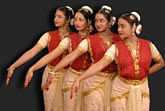
Called 'Prayog: A Dialogue between Dance and Mathematics', the performance at the Kamani Auditorium here Friday evening probed the numbers and the cosmic geometric shapes that form the core of this ancient dance form.
The dance-drama, performed by a five-member ensemble of mostly American women of Indian origin, focussed on the nodal geometric shapes, natural angles that the axis of the body makes with the limbs while dancing and postures from temple sculptures, through short choreographies.
It was presented by Viji's Philadelphia-based Three Aksha Institute of Performing Arts and hosted by the Indian Council for Cultural Relations.
Historians say Bharatnatyam originated in the temples of Thanjavur in Tamil Nadu and the modern form of the dance continues to draw inspiration from the temples of south India.
Some of the compositions in 'Prayog' used circus techniques like the ribbon dance to highlight the natural triangles, angles and parallelograms that the body makes while dancing, with the help of white ribbons.
The themes were everyday -- from the ritualistic 'shringar' to the invocation of the gods, rhythms of nature, dance of the peacocks, rain, journey of light and drawing of water from a river. But every motion used the cardinal numbers 3, 4, 5, 7 and 9 to arrive at a figure of 32, which is the basic numerical structure of Bharatnatyam body postures and compositions.
"I wanted to show the typical traditional nuances of Bharatnatyam, classical choreography and the links between the dance and mathematics," 31-year-old Viji, the director of the Three Aksha Institute that teaches the Kalakshetra style of Bharatnatyam, said.
Viji, who studied modern ballet in a dance company in Britain for 11 years after learning Bharatnatyam in India, said the idea to show the dialogue between Bharatnatyam and mathematics was prompted by the fact that “people often talk about math in dance; but no one has ever explored it”.
"Bharatnatyam uses the cardinal numbers 3, 4, 5, 7 and 9 to arrive at a figure of 32 through various permutations and combinations of body postures like three in combination with four, three and three adding up to six and four divided by three. Most of the postures are characterised by three angular nodes, linear formations like straight lines and circular patterns,” said the danseuse, who has also worked as a circus artist.
Every number and shape, explains Viji, has a religious significance.
"While (Hindu god) Narayana is a straight line, (goddess) Parvati signifies three in Bharatnatyam because of the natural triangle her busts and upper limbs make in temple structures. Shiva is number five, controlling the five natural elements,” Viji said.
Bharatnatyam, she said, originally comprised 108 karnas or temple postures.
"But we kept our choreographies to the basic 32 and confined the geometric patterns made by dancers to triangles, circles and pentagons because we had only five dancers.”
The ensemble mostly used three Nritta (pure dance) nuances of Alarippu (initial flower bud or awakening formation), Mallari (invocation of Shiva) and Tilanna (brisk and pure sculpture dance) - the three basic Bharatnatyam components.
"We also tried a couple of Swara kattus (dance with verbal sounds), but eliminated the texts and also experimented with tribhangis - in which the body is broken into sharp triangles at hands, legs and the knee," she said.
The ensemble is working on a new project called 'Faces', inspired by recession and workplace discontent. “It is based on the martial art from Kerala Kalaripayattu,” Viji said.
'Prayog', which is now on its way to Pune, is on a six-city tour of India.